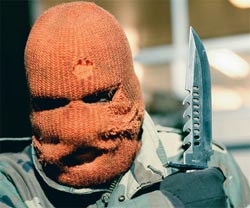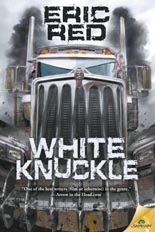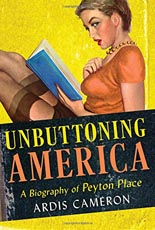 Like fellow best-sellers-turned-films Catch-22 and The Stepford Wives, Peyton Place has entered pop culture in a way that its title has become a household term whose definition is known even to those who haven’t consumed the source material. Grace Metalious’ 1956 novel, however, is the only one to ignite an all-out scandal for its frankness of postwar life in the U.S.: one marked by sex, rape, murder and more sex. What it did — and undid — is chronicled by Ardis Cameron in Unbuttoning America: A Biography of Peyton Place. “To read Peyton Place today is to ponder the sexual quicksand on which women (and men) walked,” Cameron writes, and while she does touch on the Oscar-nominated movie, the long-running TV series and the multitude of sequels, the focus is on Metalious book and its role in bringing suburbia’s secrets out from under the well-Hoovered rugs and ushering in feminism’s second wave. A decade in the making that draws upon decades of letters and other documents, Cameron’s Cornell University Press hardcover release is the best kind of history lesson: shocking, entertaining, enlightening, vital.
Like fellow best-sellers-turned-films Catch-22 and The Stepford Wives, Peyton Place has entered pop culture in a way that its title has become a household term whose definition is known even to those who haven’t consumed the source material. Grace Metalious’ 1956 novel, however, is the only one to ignite an all-out scandal for its frankness of postwar life in the U.S.: one marked by sex, rape, murder and more sex. What it did — and undid — is chronicled by Ardis Cameron in Unbuttoning America: A Biography of Peyton Place. “To read Peyton Place today is to ponder the sexual quicksand on which women (and men) walked,” Cameron writes, and while she does touch on the Oscar-nominated movie, the long-running TV series and the multitude of sequels, the focus is on Metalious book and its role in bringing suburbia’s secrets out from under the well-Hoovered rugs and ushering in feminism’s second wave. A decade in the making that draws upon decades of letters and other documents, Cameron’s Cornell University Press hardcover release is the best kind of history lesson: shocking, entertaining, enlightening, vital.
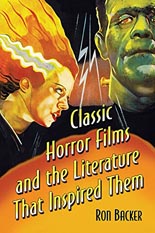 So writes Ron Backer in the introduction to his latest book from McFarland, Classic Horror Films and the Literature That Inspired Them, “I was surprised to learn how many classic horror films were based on works of literature. Who knew?” Um … everyone? I’ll cut the guy some slack, though, because the end result is a pretty enjoyable work of quasi-encyclopedic film studies, examining the “true symbiotic relationship in experiencing the same tale of horror in two different forms of art.” To that end, Backer covers 43 novels and short stories, and 62 subsequent movies across 40 thorough, judiciously illustrated chapters. From Universal to Hammer, your usual monstrous suspects are here, but to his credit, he also scopes out some obscurities, including Clements Ripley’s Black Moon, William Sloane’s The Edge of Running Water and Jessie Douglas Kerruish’s The Undying Monster. On the more contemporary side, he finishes with two early works by one Stephen King.
So writes Ron Backer in the introduction to his latest book from McFarland, Classic Horror Films and the Literature That Inspired Them, “I was surprised to learn how many classic horror films were based on works of literature. Who knew?” Um … everyone? I’ll cut the guy some slack, though, because the end result is a pretty enjoyable work of quasi-encyclopedic film studies, examining the “true symbiotic relationship in experiencing the same tale of horror in two different forms of art.” To that end, Backer covers 43 novels and short stories, and 62 subsequent movies across 40 thorough, judiciously illustrated chapters. From Universal to Hammer, your usual monstrous suspects are here, but to his credit, he also scopes out some obscurities, including Clements Ripley’s Black Moon, William Sloane’s The Edge of Running Water and Jessie Douglas Kerruish’s The Undying Monster. On the more contemporary side, he finishes with two early works by one Stephen King.
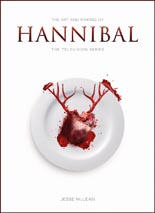 One would guess that learning the secrets behind the gruesome special effects of Hannibal would make the show less freaky. Nope! If anything, Jesse McLean’s The Art and Making of Hannibal: The Television Series just makes it creepier. Seeing such freak-of-the-week stuff like the neck cello, corpse totem and the bee man (oh, Lord, not the trypophobic bee man!) up-close is entirely unsettling when it’s staring you in the face in four colors and large spreads vs. fleeting across the cathode rays of a mainstream-network show. Titan Books releases a slew of these behind-the-scenes volumes with a production quality closer to the coffee table than the “collector’s” fan magazine of yesteryear, but few seem to merit such curtain-peek treatment; Hannibal, however, is a series that actually deserves this treatment. Its top-class ghastliness is matched by intelligent scripts, crisp direction and delicious performances; McLean’s sleekly designed trade paperback mirrors the series’ credibility.
One would guess that learning the secrets behind the gruesome special effects of Hannibal would make the show less freaky. Nope! If anything, Jesse McLean’s The Art and Making of Hannibal: The Television Series just makes it creepier. Seeing such freak-of-the-week stuff like the neck cello, corpse totem and the bee man (oh, Lord, not the trypophobic bee man!) up-close is entirely unsettling when it’s staring you in the face in four colors and large spreads vs. fleeting across the cathode rays of a mainstream-network show. Titan Books releases a slew of these behind-the-scenes volumes with a production quality closer to the coffee table than the “collector’s” fan magazine of yesteryear, but few seem to merit such curtain-peek treatment; Hannibal, however, is a series that actually deserves this treatment. Its top-class ghastliness is matched by intelligent scripts, crisp direction and delicious performances; McLean’s sleekly designed trade paperback mirrors the series’ credibility.
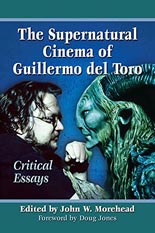 My hot-and-cold reaction to the subject of The Supernatural Cinema of Guillermo del Toro: Critical Essays can be summed up by the opening and closing lines of actor Doug Jones’ foreword: “Guillermo del Toro. A name that makes film fans buckle at the knee in reverence. … The man to whom I will forever be grateful for allowing me name to be associated with his in some of the most respected films in the history of cinema.” Geez, get a room! Del Toro is a serious talent, but he can do wrong; for starters, his running times show he doesn’t know how to quit while he’s ahead. And yet, I enjoyed reading about films I’m not particularly fond of in this John W. Morehead-edited collection from McFarland. It dives into issues of religious symbolism, childhood trauma, insect obsession and other recurring themes in movies great (Pan’s Labyrinth), good (Blade II), bad (Hellboy II: The Golden Army) and, um, Pacific Rim.
My hot-and-cold reaction to the subject of The Supernatural Cinema of Guillermo del Toro: Critical Essays can be summed up by the opening and closing lines of actor Doug Jones’ foreword: “Guillermo del Toro. A name that makes film fans buckle at the knee in reverence. … The man to whom I will forever be grateful for allowing me name to be associated with his in some of the most respected films in the history of cinema.” Geez, get a room! Del Toro is a serious talent, but he can do wrong; for starters, his running times show he doesn’t know how to quit while he’s ahead. And yet, I enjoyed reading about films I’m not particularly fond of in this John W. Morehead-edited collection from McFarland. It dives into issues of religious symbolism, childhood trauma, insect obsession and other recurring themes in movies great (Pan’s Labyrinth), good (Blade II), bad (Hellboy II: The Golden Army) and, um, Pacific Rim.
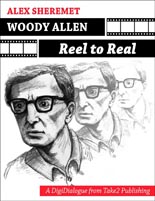 Select films of Woody Allen can exude so much neuroses to make the unaccustomed viewer cringe in discomfort. No scene, however, matches the awkwardness of a section within Woody Allen: Reel to Real, in which author Alex Sheremet exchanges emails with esteemed film critic Jonathan Rosenbaum over the latter’s negative remarks of Allen’s work in the past; it soon devolves into a war of words. “Wait,” you ask, “why is such a thing even included in a book?” Easy: Because Reel to Real is not a conventional text, but Take2 Publishing’s inaugural “DigiDialogue” experiment. In short, that’s a fancy term for “ebook,” but one that Sheremet vows will be updated periodically — not just as Allen makes new pictures (roughly one every year), but as readers converse with the author and one another on the films covered and opinions shared, as if an Internet forum were built-in. While the comments are not yet incredibly in depth in number (per the March 31 review copy I read), this undoubtedly will grow and be interesting for hardcore Allen fans to follow. Even without this feature, Sheremet’s insights on the films make for intelligent criticism; his chronologically arranged essays grow in length as Allen moves from “the early, funny ones” to “sitting at the grown-ups’ table.” Join the discourse! —Rod Lott
Select films of Woody Allen can exude so much neuroses to make the unaccustomed viewer cringe in discomfort. No scene, however, matches the awkwardness of a section within Woody Allen: Reel to Real, in which author Alex Sheremet exchanges emails with esteemed film critic Jonathan Rosenbaum over the latter’s negative remarks of Allen’s work in the past; it soon devolves into a war of words. “Wait,” you ask, “why is such a thing even included in a book?” Easy: Because Reel to Real is not a conventional text, but Take2 Publishing’s inaugural “DigiDialogue” experiment. In short, that’s a fancy term for “ebook,” but one that Sheremet vows will be updated periodically — not just as Allen makes new pictures (roughly one every year), but as readers converse with the author and one another on the films covered and opinions shared, as if an Internet forum were built-in. While the comments are not yet incredibly in depth in number (per the March 31 review copy I read), this undoubtedly will grow and be interesting for hardcore Allen fans to follow. Even without this feature, Sheremet’s insights on the films make for intelligent criticism; his chronologically arranged essays grow in length as Allen moves from “the early, funny ones” to “sitting at the grown-ups’ table.” Join the discourse! —Rod Lott
Get them at Amazon.
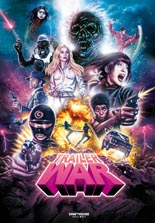
 No war is to be fought with Trailer War. We all win.
No war is to be fought with Trailer War. We all win. 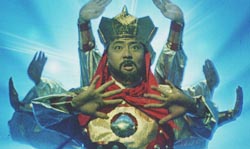 Among the goods are such bads and uglies as:
Among the goods are such bads and uglies as:
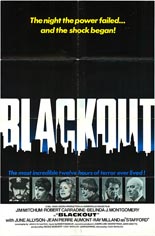
 Time and time again, the movies prove that drivers for any given state’s Department of Corrections are the worst. Fifteen years before the best example of this —
Time and time again, the movies prove that drivers for any given state’s Department of Corrections are the worst. Fifteen years before the best example of this — 
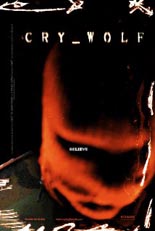
 While the hero of
While the hero of 